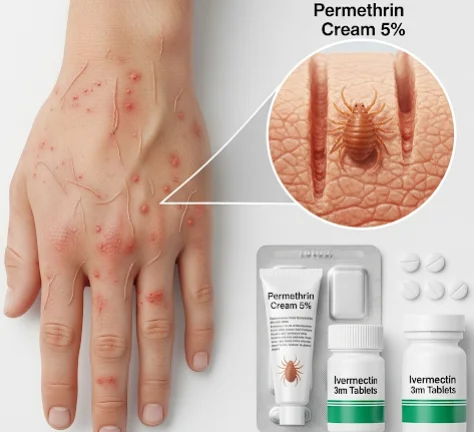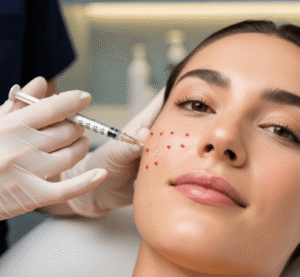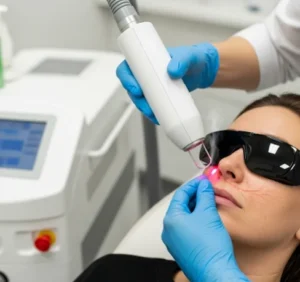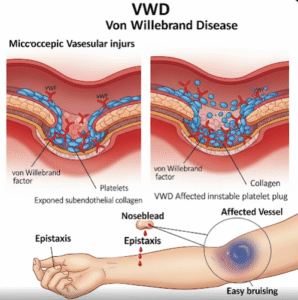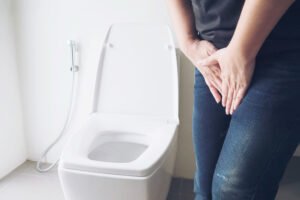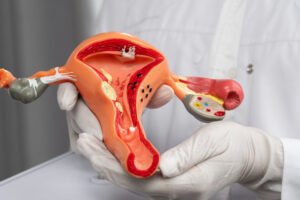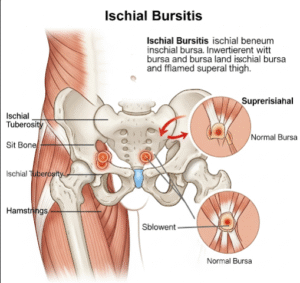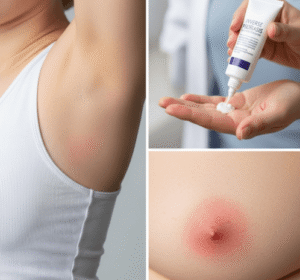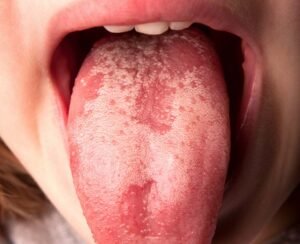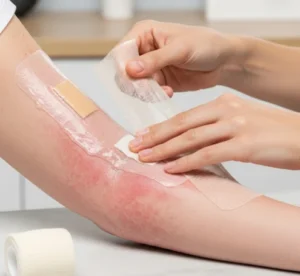What it is
➝ Scabies is a contagious parasitic skin infestation caused by the Sarcoptes scabiei mite, which burrows into the skin and causes intense itching, rash, and burrows.
➝ Standard treatment is with topical permethrin 5% cream, but in severe, crusted, or resistant cases, a combination of permethrin and oral ivermectin is recommended.
➝ This dual approach is highly effective because permethrin kills mites on the skin surface while ivermectin targets mites systemically, preventing reinfestation.
➝ In Korea, dermatology clinics frequently use permethrin + ivermectin combination therapy in cases of widespread scabies, institutional outbreaks, immunocompromised patients, or treatment-resistant infestations.
Why it’s done
→ To rapidly eliminate mites in severe, widespread, or resistant scabies.
→ To control crusted scabies, which carries high mite burden and risk of outbreaks.
→ To reduce treatment failures, which sometimes occur with permethrin alone due to poor application or incomplete coverage.
→ To improve outcomes in high-risk patients such as the elderly, immunocompromised, or institutionalized populations.
→ In Korea, this strategy is often used in hospital outbreaks or nursing home settings for faster eradication.
Alternatives
→ Topical permethrin alone: Standard first-line treatment for most uncomplicated cases.
→ Oral ivermectin alone: Useful when topical therapy is not practical, but less effective than combination in crusted scabies.
→ Other topical agents: Benzyl benzoate, sulfur ointment, crotamiton (less common in Korea).
→ Adjunct measures: Antihistamines for itch relief, topical corticosteroids for post-scabetic eczema.
Preparation
→ Confirm diagnosis clinically or with skin scrapings, dermoscopy, or microscopy.
→ Patients are educated on the importance of treating all household members and close contacts simultaneously.
→ Bedding, clothes, and towels must be washed in hot water and dried on high heat, or sealed in bags for at least 72 hours.
→ In Korea, clinics often distribute treatment checklists for families and institutions to ensure correct application and environmental control.
How it’s Done
→ Permethrin 5% cream:
- Applied to the entire body from the neck down (including scalp in infants and elderly).
- Left on for 8–14 hours before washing off.
- Reapplied after 7 days to kill newly hatched mites.
→ Oral ivermectin:
- Dose: 200 µg/kg orally, taken with food.
- Usually given as two doses, one on day 1 and a second on day 8–14.
- In crusted scabies, more doses may be required (e.g., days 1, 2, 8, 9, and 15).
→ Combination:
- Permethrin cream applied as above.
- Oral ivermectin given simultaneously on day 1 and repeated on day 8–14.
- Ensures both surface and systemic eradication.
→ Symptomatic relief:
- Antihistamines for itching.
- Mild topical steroids or emollients for dermatitis.
Recovery
→ Itching often persists for 2–4 weeks after treatment due to allergic reaction to mite debris (post-scabetic itch).
→ New burrows should stop appearing within 1–2 weeks if treatment is effective.
→ Skin gradually clears over 2–6 weeks, depending on severity.
→ Combination therapy reduces recurrence risk and clears infestations faster than monotherapy.
Complications
→ Permethrin side effects: Mild burning, stinging, or irritation of skin.
→ Ivermectin side effects: Usually well tolerated, but may cause dizziness, mild GI upset, or rash.
→ Treatment failure: May occur if application is incomplete or close contacts are untreated.
→ Secondary bacterial infection: Scratching can lead to impetigo or cellulitis if not controlled.
Treatment Options in Korea
→ Korean dermatologists often use permethrin + ivermectin combo therapy for:
- Crusted scabies.
- Resistant scabies not cleared by permethrin alone.
- Institutional outbreaks in hospitals, nursing homes, and long-term care facilities.
→ Hospitals implement simultaneous mass treatment for all exposed individuals to prevent reinfection.
→ Clinics emphasize environmental disinfection, often giving patients and families detailed guidance on washing bedding, vacuuming furniture, and disinfecting shared items.
→ Post-treatment care in Korea includes soothing K-beauty moisturizers and barrier creams to reduce itching and skin irritation.
→ With this comprehensive approach, Korea achieves high clearance rates and low recurrence rates, even in high-risk populations.

